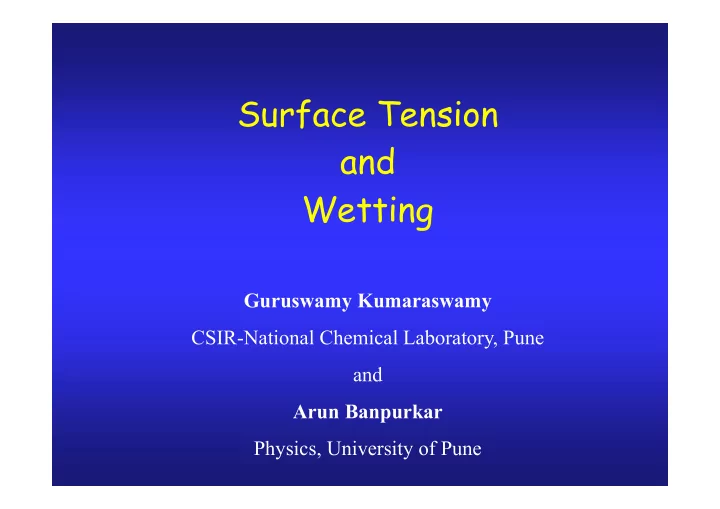

Surface Tension and Wetting Guruswamy Kumaraswamy CSIR-National Chemical Laboratory, Pune and Arun Banpurkar Physics, University of Pune
Let’s start with some chemistry What is?
Let’s start with some chemistry What is?
Let’s start with some chemistry What is?
Let’s start with some chemistry What is?
Let’s try some more chemistry What is? What are the properties of H 2 O?
Let’s try some more chemistry What is? What are the properties of H 2 S?
We expect S and O to have similar properties... H 2 S a gas while H 2 O is a liquid . WHY? The difference between a gas and a liquid? http://www.chem.purdue.edu/gchelp/atoms/states.html Molecules in a liquid are STUCK to each other
http://chemistry.stackexchange.com/questions/4315/covalent-bond-hydrogen-bond http://www.columbia.edu/cu/biology/courses/c2005/lectures/lec2_10.html phase together in liquid molecules tightly holds water attractive force that hydrogen bonds Water forms
http://www.nature.com/nature/journal/v474/n7350/full/474168a.html What happens at the surface of water? This happens in the bulk
http://chem.libretexts.org/LibreTexts/University_of_California_Davis/ UCD_Chem_002BH/Unit_II%3A_States_of_Matter/10%3A_Solids,_L DANGLING BONDS Interface water molecules can’t H-bond with air where bonds are very different from the bulk ONE molecule thick layer of water iquids,_and_Phase_Transitions/10.1%3A_Bulk_Properties_of_Gases,_ Liquids,_and_Solids%3A_Molecular_Interpretation
Can think of this as a SKIN for water The force that holds the skin together is the surface tension http://hyperphysics.phy-astr.gsu.edu/hbase/surten.html Due to strong H-bonding, water has a really high surface tension (72 mN/m at RT)
Surface tension – how much is 72 mN/m? - Water “skin” can hold up insects… - Can water “skin” support the weight of dense metal objects? Can metal objects float? But, this has nothing to do with surface tension Remember Archimedes? Is 72 mN/m sufficient to hold up a paper clip?
Can the skin of water pull itself up, into a tube? Net force Surface tension Surface tension “skin” force “skin” force https://upload.wikimedia.org/wikipedia/commo ns/6/66/CurvedSurfaceTension.png
Some creepy crawlies have learnt some really cool ways of using surface tension effects Multimedia Fluid Mechanics: Cambridge University Press
Where do we encounter capillarity? Chromatography Wet hair, fibers stick together
Wet sand sticks together http://water.usgs.gov/edu/pictures/full-size/plant-uptake-large.jpg Plant uptake Is this the only mechanism for water uptake? Does this set a limit on how high plants can grow?
http://www.pharmaceutical-technology.com/projects/chengdu- vaccine/chengdu-vaccine3.html control dengue? Why does adding soap to stagnant water help Question:
What happens when we add soap to water? Covering the skin – Changing surface tension Tails don’t stick so strongly Skin force decreases a lot https://skullsinthestars.files.wordpress.com/2012/05/soapmolecule.png http://soapbubble.dk/wp-content/uploads/2013/10/Dias41.jpg https://upload.wikimedia.org/wikipedia/commons/0/03/Surfactant.jpg
Making surface tension anisotropic Marangoni effect https://upload.wikimedia.org/wikipedia/en/1/1f/Figure2a-Camphor_Boat.jpg Camphor boat experiment
Temperature also changes surface tension Multimedia Fluid Mechanics: Cambridge University Press
Now, let’s talk about WETTING http://www.hk-phy.org/atomic_world/lotus/lotus02_e.html The contact angle tells us about wetting Hydrophobic: > 110 o SUPER-hydrophobic: > 160 o
WETTING depends on whether the solid likes the liquid Oil and water hate to mix https://www.propublica.org/images/articles/flickr_dw http://i2.cdn.cnn.com/cnnnext/dam/assets/150519135 626-01-oil-spill-0520-exlarge-169.jpg h_oilslick_300x200_100615.jpg Solids that like water, don’t like oil and Solids that like oil, don’t like water Can we use this to separate oil and water?
Sponges that love oil but hate water
We’ve made - HYDROPHOBIC sponges that are capable of absorbing hexane (dyed red) underwater - OMNIPHILIC sponges: absorb > 10X their weight of water OR oil
Problem: How do we efficiently get hydrophobic pesticides onto leaves? Pesticide use can contaminate food, soil, water
In general, leaf surfaces are HYDROPHOBIC Leaf surfaces have a waxy coating. Therefore, they hate water. Water on rose leaf tilted at 30 o
We’ve done some work on this problem Food grade nanoparticles
We’ve done some work on this problem NP/water on rose leaf at 30 o
We’ve done some work on this problem We have discovered that nanoparticles (prepared from sunflower oil) can solve this problem These nanoparticles are non-toxic. In fact, they are food-grade (viz. you can eat them)
SUPERHYDROPHOBICITY Natural superhydrophobic surface: Lotus leaf
High speed imaging of water drop falling on lotus leaf
Drops of water/our nanoparticle dispersions on Lotus leaves
THANK YOU g.kumaraswamy@ncl.res.in
Recommend
More recommend